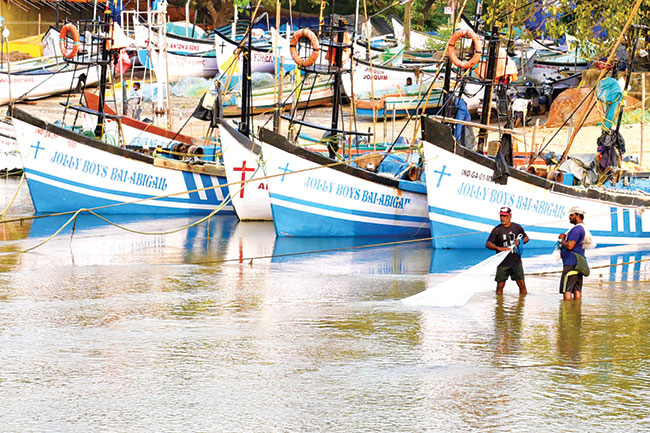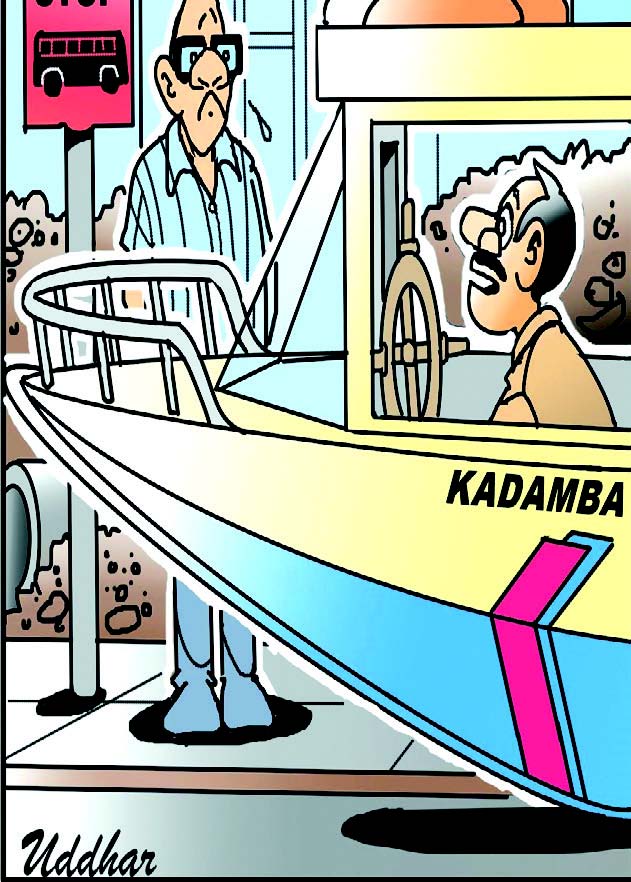A State committee was formed last year for the preparation of a draft comprehensive plan for the fishermen community living in CRZ areas. The Committee examined various documents provided by concerned govt departments and research papers on the subject matter. Further, the Committee also undertook site visits and held several meetings to deliberate on the requirements of the fishermen community living in the CRZ areas of the State. They have summarised the present status of fisheries in Goa and what needs to be done within the notification of the CRZ Notification 2011. They also observed how the location of the fishing community makes them vulnerable to coastal hazards such as erosion, shoreline changes, flash floods and cyclonic weather. The Committee suggested how the fishing community’s vulnerability to such hazards can be minimised by proper adoptive and preventive measures. This 11-member committee headed by its Chairman and expert Dr Simon D'Souza recently submitted its exhaustive report to the government, which is supposed to be considered for the draft Coastal Zone Management Plan (CZMP). However, stakeholders complain that these recommendations, which should have been incorporated in the draft CZMP, are not reflected in the same.
1 Undisturbed beach areas shall be reserved for fish landing, 'canoe/boat' parking and traditional "ramponn" fishing activity on shore. Due to the continuous expansion of tourism activities, the beaches and areas along the coast of the beach are being slowly occupied for tourism related "structures/facilities". At times, there is no place for fishermen to land or berth their canoes on the beach as the shack, water sports operators and sub-bathing chairs continuously use the whole stretch for their business. Similarly, traditional fishermen who operate the "ramponn", a very long net installed between the Low Tide Line (LTL) and High Tide Line (HTL) to catch fish, require a large undisturbed part of the beach for their regular operation. On busy beaches (viz, Calangute, Candolim, Baga, Anjuna, Colva and Palolem) during the peak tourism season, conflicts arise between the local fishermen and tourism stakeholders for space on the beach. It is therefore necessary on such busy beaches, beyond which the tourism stakeholders should not be allowed to operate. The rest of the area on the beaches shall be kept free for the local fishing community to conduct their traditional chores related to fishing.
2As per the claim of the fishing community living in CRZ areas of Goa, several of their dwelling units permissible as per the provisions of erstwhile CRZ Notification of 1991 are yet to be regularised. Such dwelling units can be considered for recommendation under Clause 6 (d) of CRZ 2011 notification. Accordingly, it is recommended that the GCZMA may conduct a 'fishing-ward' wise survey of such dwelling units, which were permissible under CRZ 1991 Notification and are yet to be regularised. Consequently, eligible dwelling units may be regularised on a case-by-case basis as per the above cited Clause and as provided under Clauses 8 III A (ii) (first part) and 8 III B (vii) & (ix) of the CRZ 2011 notification. In the process, it is imperative to check the genuineness of each case and ensure that such dwelling units; due for regularisation and are not used for any commercial activity and are not sold or transferred to non-traditional coastal community. In such cases, where such un-regularised dwelling units are located within 200 m to 500 m from the HTL line, the provisions of Clause 8 III b of CRZ 2011 Notification may be used to allow maximum possible extension of their units in accordance with the prevailing TCP regulations.
3 Clause 8 III A (ii) of CRZ 2011 Notification permits 'construction/reconstruction' of dwelling units of traditional coastal communities including fisher-folk between 100 m and 200 m from the HTL along the seafront in accordance with a comprehensive plan (CZMP plan) prepared by the State government in consultation with the traditional coastal communities including fisher-folk and incorporating the necessary Disaster Management Plan (DMP), sanitation and recommended by the GCZMA to NCZMA for approval by MOEF& CC.
As per the Draft Goa CZMP prepared by the National Centre for Sustainable Coastal Management (NCSCM), there are 186 fishing wards falling within or adjacent to the CRZ area where the fishing activities are carried out in the State of Goa. A 100m buffer line has been drawn from HTL to the landward side in case of fishing wards near the sea coast to facilitate the above stated special consideration available for the Fishing Community in Goa.
A detailed survey of the said CRZ belt falling within 100 to 200 m of the HTL shall be conducted to identify both the housing needs and land ownership of the traditional fishing community living therein. The planning strategy to be followed to allow construction of dwelling units in this belt may be restricted to the principle adopted in the CRZ Regulations and also reiterated in the Report on "Carrying Capacity of Beaches of Goa for Providing Shacks and Other Temporary Seasonal Structures in Private Areas" prepared for the GCZMA by the NCSCM (Chennai) in December, 2016.
Accordingly, assuming that the traditional 'coastal/fishermen' communities own developable plots within the CRZ belt of 100 m to 200 m of HTL (on landward side), it is recommended that the “construction/reconstruction" of proposed dwelling units shall be permitted, provided that these:
(i)
Are within the ambit of traditional rights and customary uses (such as fishing villages and 'goothans')
(ii)
Have a maximum FSI of 0.50 with ground coverage limited to 40%.
(iii) Are restricted to two floors (ground plus one) with overall height of the structure not exceeding 9 m (i.e, the vertical distance measured from the ground level at the base of the outside wall to the highest ridge of the roof).
(iv) Are not used for any commercial activity
(v) Are not sold or transferred to non-traditional coastal community.
Based on the results of the survey to be carried out and the construction norms, recommended hereinabove, a Comprehensive Plan (CP) for the proposed dwelling units of traditional fishermen in this CRZ belt (100 m to 200 m of HTL, on the landward side) shall be prepared and officially approved. Specific proposals for construction of dwelling units as per the said norms shall be then promptly approved (on a case-by-case basis) in accordance to the said CP.
4Clause 8 III A (III) (I) of CRZ 2011 Notification permits facilities for local fishing communities such as fish drying yards, auction halls, net mending yards, traditional boat building yards, ice plants, ice crushing units, ice storage, fish curing facilities, jetties and the like, within the 'No Development Zone' (NDZ) of CRZ III (i.e, belt of 200 m from HTL, on landward side). Further, Clause 8 V3 (i) permits the State government to notify the fishing villages wherein all such foreshore facilities required for fishing and allied activities, may be permitted by the concerned Gram panchayat in CRZ area.
A Fishery Planning Committee (FPC) comprising representatives of GCZMA, Directorate of Fisheries and three knowledgeable representatives of Fishermen Community may study the genuine need of such facilities in major fishing villages and prepare an indicative Plan (IP) for the same duly superimposed on respective Cadastral Scale Village CRZ Plans. These may be notified village wise for prompt action by the concerned village panchayats. The Department of Fisheries has identified a number of feasible sites wherein the above infrastructure can be developed. The FPC may examine the proposed sites in the village and recommend developing the facilities promptly that are genuinely needed to the fishermen community.
5Sanitary facilities such as adequate water supply, community toilets, sewage 'treatment ‘disposal', wash rooms and dispensaries with first aid facility are necessary for the welfare of the fishing community, as near the shore as possible. In CRZ III areas, the CRZ 2011 Notification under Clause 8 III A (iii) (j), (K) and Clause 8 III B (viii) permits the establishment of such facilities within ("HTL to 200 m" on sea shore/ "HTL to max of 100 m" along tidal water bodies) and ("200 m to 500 m" belts along the sea shore), respectively. It is recommended that such facilities, as far as possible be provided as components of Auction Hall, Fish Market 'and/or' Community Toilet. Public Rain Shelters and minor approach pathways are also permissible in these CRZ belts under the same Clauses. Fishing "boats/trawlers" and other mechanical gear require "storage/supply" of petroleum products within the CRZ to maintain and run the same. This is permissible vide Clause 8 III A (iii) (e) and Clause 8 III B (ii) of CRZ Notification (2011) in the above cited CRZ belts. The Fishing "village/ward" wise requirements of the above mentioned facilities including Garbage Collection and Disposal services shall also be determined by the said FPC and presented to the GCZMA for speedy action through the respective panchayats.
6The FPC in consultation with the Goa New & Renewable Energy Development Agency shall implement a new scheme to provide Solar Photo-Voltaic lighting for common spaces and Solar Thermal Water Heating systems for houses within the wards of fishing community.
7 Government shall plan the establishment of Garden cum Recreational Area, wherever possible, in the NDZ of CRZ III area for the benefit of local traditional fishing communities. This is permitted under Clause 8 III A (iii) (a) of the CRZ 2011 notification.
8For a total number of 70 fishing villages (37 South/33 North)* and 2,844 fishing crafts (904 mechanised/1669 motorized/balance non-motorized), the State has 33* Landing Centres. Presently, Seven Jetties (Major: Chapora, Malim, Cortalim, Khariwada, Cutbona & Talpona) and 33 Ramps cater to the needs of the said fleet. The FPC may examine the current status to assess the need for additional such facilities and suggest locations for the same along the coastline and estuarine banks.
9 As per the Census of 2010, Goa had a fishermen population of 2189 families (801 North/ 1388 South) with a total of 10,545 persons. Accordingly, the average number of fishing families and number of persons per village work out to 56 and 270 respectively. The average family size is 4.08 members. Population wise, the largest village is Betul, Bapsora (Salcete) with 761 persons (228 active) and the smallest is Mandrem with 37 persons (7 active). It is important to note that the large villages such as Calangute, Candolim and Colva, which have maximum tourism activity, have relatively lesser populations of fishermen. The FPC may examine to find out if this is the consequence of either the fishermen moving away from their traditional occupation, sub-letting their work to migrant workers or both. This will also influence the housing needs of the local fishing community to accommodate their workers.
10The demand for shellfish is high in Goa. However, there is a threat of decline in the shellfish found in the wild due to over exploitation, pollution or encroachment. Further most of the breeding sites are continuously being disturbed for tourism related activities. Thus in order to protect these sites from anthropogenic influence, the Directorate of Fisheries has identified breeding zones of shell fish across Goa and these shall be earmarked.

